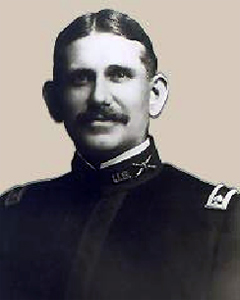Colonel
Isaac N. Lewis
 Colonel Isaac N. Lewis was born in
New Salem, Pennsylvania on October 12, 1858 and graduated from the United States Military Academy in 1884. His
most notable contribution was the invention, development, and full-scale production of the world's first
lightweight machine gun for aircraft.
Colonel Isaac N. Lewis was born in
New Salem, Pennsylvania on October 12, 1858 and graduated from the United States Military Academy in 1884. His
most notable contribution was the invention, development, and full-scale production of the world's first
lightweight machine gun for aircraft.
Other contributions were a patented depression position finder, a plotting and relocating system for seacoast batteries, a time-interval clock and bell system of signals of artillery fire control, a quick-firing field gun and mount, a quick-reading mechanical vernier, a patented electric car lighting system, a windmill electric lighting system, and a patented gas-propelled torpedo.
As a lieutenant in 1884, he invented the world's first artillery range and position finder. On June 7, 1912 he and two military aviators made history by firing a machine gun from an airplane for the first time. The Army failed to envision the usefulness of the new weapon, which he had offered to the service virtually free of charge; the Marine Corps, however, accepted his offer.
He was unable to secure the approval of the war department, so after his retirement in 1913 he went to Belgium to build a factory for the production of his machine gun. He operated this factory until 1920. During the early part of World War I, Lewis machine guns were delivered to the Allies at a rate of 3,500 per week. After much controversy, the war proven gun was accepted by the government and the Lewis machine gun totally changed the deployment of automatic weapons on the battlefield. Colonel Lewis died in New Jersey on November 9, 1931.